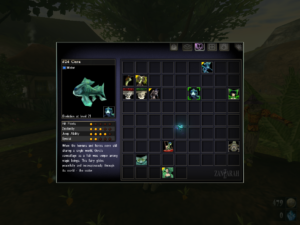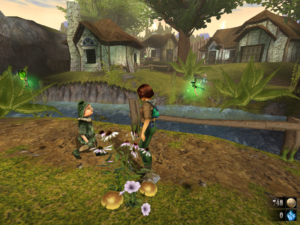Zanzarah: Elements
In Zanzarah, elemental powers are key. Every fairy belongs to one element, and every element is strong against some other elements, weak against others, and indifferent to the rest. (Canonical example: water is strong against fire. Someday I’d like to see a game that reverses that just to mess with us.) A fairy can easily beat an opponent that’s twice its experience level if it’s a kind that it’s strong against, and will probably gain an experience level for doing so without the assistance of other fairies. And since gaining a level restores a fairy’s health and partially restores its mana, this is a good way to make extended explorations without spending a lot on restoratives. I can imagine catching fresh low-level fairies specifically to take advantage of this.
The elements are: Nature (plants), Stone, Water, Air, Psi, Ice, Dark, Energy (electric), Chaos, Flame, Light, and Metal. That’s not quite the same as the Pokémon element list, but there’s a substantial overlap. You can often tell what elements you’ll encounter from the terrain — for example, snowy mountain peaks abound in Stone and Ice types — but the type is pretty much an arbitrary designation with no effect on gameplay. There are exceptions, though, where attacks have special effects. For example, there are Ice attacks that temporarily slow or freeze the opponent (in addition to doing damage), and a Psychic spell that teleports its target to a random spot on the battlefield. Now, unlike in Pokémon, attacks are not specific to particular species of fairy; any attack can be bought from a spell merchant and equipped on any fairy that’s the right element and is powerful enough to use it. So I could use these special effects if I wanted to, but they never really seem worthwhile. The freeze attack would be nice, but it can only be cast five times before refueling, and that’s often insufficient for even a single fight. The teleportation attack seems outright harmful to the caster: it takes an opponent that’s in your sights and removes it. So, for me, these specials are pretty much only done by the opponent. My own fairies are just damage-dealers in different flavors.
I don’t have fairies of all the elements at my disposal yet. One really frustrating thing the game does repeatedly is withhold an element from you until you’ve managed to beat a bunch of fairies that it would be really useful against. The most recent example I’ve encountered (and haven’t overcome yet) is a Dark Elf guarding a crucial item with a team of Dark and Chaos fairies, which, unfairly, all attack you at the same time. (Although you can switch fairies mid-combat, you can have only one out at a time. Dark Elves have apparently learned to overcome this restriction.) Now, I have creatures that are strong against Dark and I have creatures that are strong against Chaos, but to survive that kind of onslaught, what you really want is something that’s strong against both. Only one element qualifies: Light. It’s possible that there’s a Light fairy hidden somewhere that I haven’t found, but more likely that I’ll gain access to my first immediately after the fight is over.
 Comments(4)
Comments(4)
